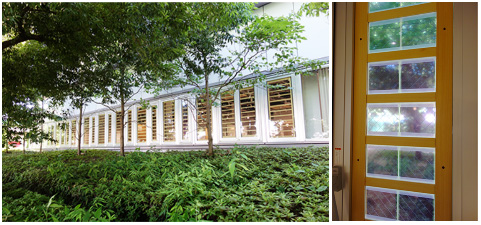Energy-Saving, Multicolor Electrochromic Dimming Glass: Proof-of-Concept in Tsukuba, Japan
2020.09.08
National Institute for Materials Science (NIMS)
Tsukuba City Hall
Japan Science and Technology Agency (JST)
The National Institute for Materials Science (NIMS) and the City of Tsukuba in Ibaraki Prefecture will jointly monitor the performance of a dimming glass composed of an electrochromic material NIMS has developed starting September 8, 2020.
Abstract
- The National Institute for Materials Science (NIMS) and the City of Tsukuba in Ibaraki Prefecture will jointly monitor the performance of a dimming glass composed of an electrochromic material NIMS has developed starting September 8, 2020. The tint of the glass can be electrically changed by simply flipping a switch. The usability of the glass will be assessed by installing it in public facility window frames and monitoring its long-term operational stability and dimming performance.
- Types of dimming electrochromic (EC) glasses capable of changing tint from transparent to dark by simply flipping a switch have been attracting a great deal of attention regarding their use in next-generation windows—technology that could eliminate the need for curtains and window blinds. Although dimming EC glasses have already been used in the Boeing 787 Dreamliner and in other objects, their use as window glasses in offices and other spaces is still limited due to power consumption and chromogenic issues. To resolve these issues, a NIMS research group has developed a metallo-supramolecular polymer EC material capable of operating in a more energy efficient manner and exhibiting more desirable chromogenic properties than existing EC materials. This new material can also be made into many different colors (e.g., blue, green, purple and black) by changing the type of metal it contains. The group then worked to put this material into practical use. Earlier this year, it developed a synthetic process that can be used to stably supply the metallo-supramolecular polymer and then produced several hundred dimming EC glass sheets composed of this polymer. The group then searched for a suitable experimental site to evaluate the durability and operability of these glass sheets installed in building windows.
- The City of Tsukuba has been fostering the growth of startup businesses and promoting the efforts of research institutes based in the city to put new technologies they developed into practical use. The city recently agreed to support the research project the NIMS research group had proposed and allowed the group to install blue and purple dimming EC glasses in the windows of Tsukuba Startup Park (2-5-1 Azuma, Tsukuba, Ibaraki), a municipal building. The long-term monitoring of the glasses’ operational stability will begin on September 8, 2020. More than 1,000 10 cm x 10 cm dimming glass sheets are scheduled to be mounted in wooden window frames that have been used in the building. We will allow facility users to operate the dimming windows during the monitoring period through March 2021, and based on their feedback we plan to make improvements such as ease of changing window tints.
- This monitoring experiment will be carried out by a research group led by Masayoshi Higuchi (Leader of the Electronic Functional Macromolecules Group, Research Center for Functional Materials, NIMS) with the support of the Tsukuba City Start-up Promotion Office. This project will be conducted in conjunction with another project entitled “Ultrafast, ultralow-power, ultralarge-area electrochromism” (research director: Masayoshi Higuchi) being carried out in the research area “Innovative nano-electronics through interdisciplinary collaboration among material, device and system layers” (research supervisor: Takayasu Sakurai) funded by the JST Strategic Basic Research Program CREST.

Figure 1. Row of building windows selected to have the dimming EC glasses installed (left) and a window frame in which the glasses are mounted (right)
Related files
- Research Center for Functional Materials
Contact information
(Regarding this research)
-
Masayoshi Higuchi
Group Leader,
Electronic Functional Macromolecules Group,
Polymers and Biomaterials Field
Research Center for Functional Materials
National Institute for Materials Science (NIMS)
Tel: +81-29-860-4744
E-Mail: HIGUCHI.Masayoshi=nims.go.jp
(Please change "=" to "@")
(Regarding JST projects)
-
Yuko Shimabayashi
Green Innovation Group, Department of Innovation Research
Japan Science and Technology Agency
K's Gobancho, 7 Gobancho, Chiyoda-ku, Tokyo 102-0076, Japan
Tel: +81-3-3512-3531
Fax: +81-3-3222-2066
E-Mail: crest=jst.go.jp
(Please change "=" to "@")
(General information)
-
Public Relations Office
National Institute for Materials Science
Tel: +81-29-859-2026
Fax: +81-29-859-2017
E-Mail: pressrelease=ml.nims.go.jp
(Please change "=" to "@") -
Start-up Promotion Office
Science and Technology Promotion Division, Policy and Innovation Department
Tsukuba City Hall
1-1-1 Kenkyu-Gakuen, Tsukuba, Ibaraki 305-8555, Japan
Tel: +81-29-883-1111
E-Mail: eco054=city.tsukuba.lg.jp
(Please change "=" to "@") -
Public Relations Division
Japan Science and Technology Agency
5-3 Yonbancho, Chiyoda-ku, Tokyo 102-8666, Japan
Tel: +81-3-5214-8404
Fax: +81-3-5214-8432
E-Mail: jstkoho=jst.go.jp
(Please change "=" to "@")
Same Keywords
-
Stable Supply of Electrochromic Metallo-Supramolecular Polymer
(EC,electrochromic,metallo-supramolecular polymer,supramolecular,polymer)
2020.06.26
-
Artwork with Nonvolatile Soft Display, Expressing Color Gradation
(electrochromic,polymer)
2019.11.25
-
Gradation-Tint Smart Window
(electrochromic,polymer)
2017.10.30
Recent Press Release
-
Simultaneous Imaging of Intracellular DNA and RNA Using Harmless Light
2025.10.27
-
Development of an AI Device Using Ion Gel and Graphene That Dramatically Streamlines Machine Learning Computations
2025.10.14
-
Demonstrating a Novel Method to Modulate Heat Flow Through the Collective Motion of Spins
2025.10.06
